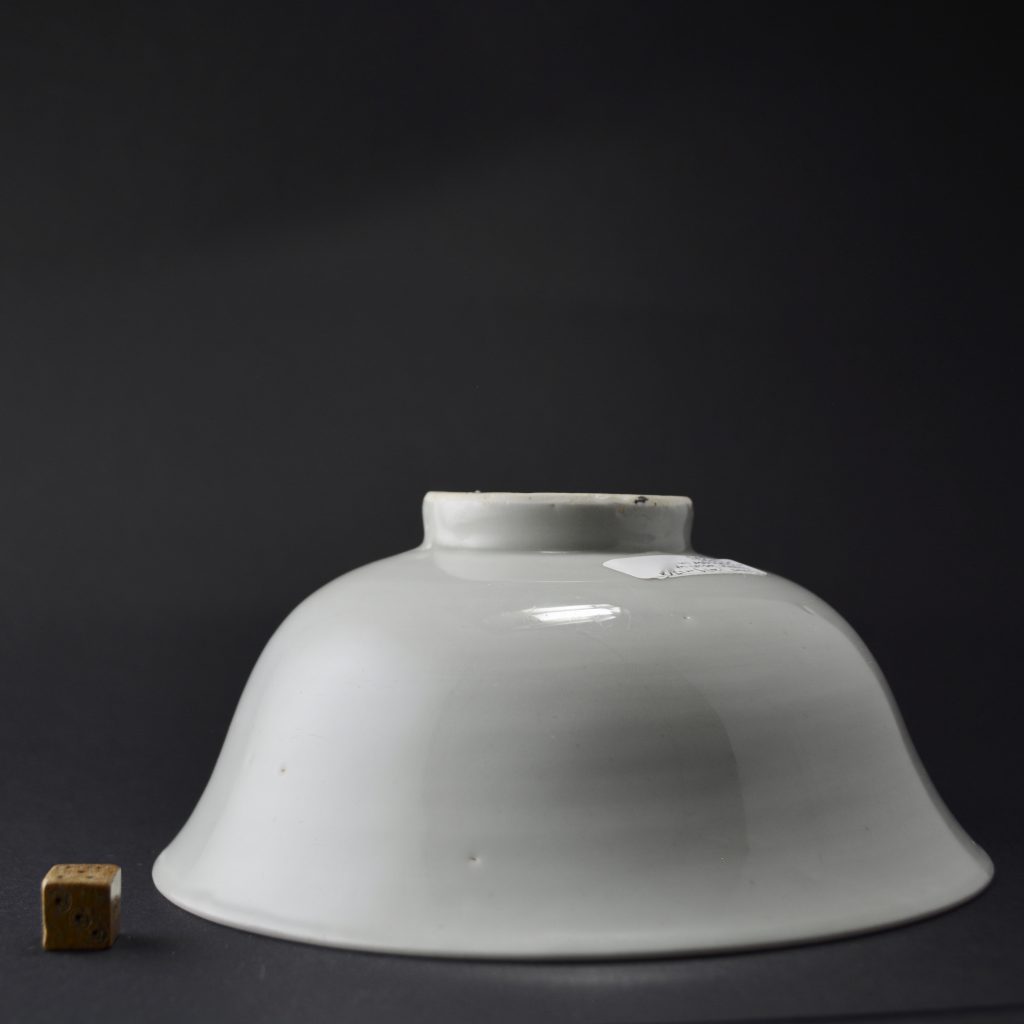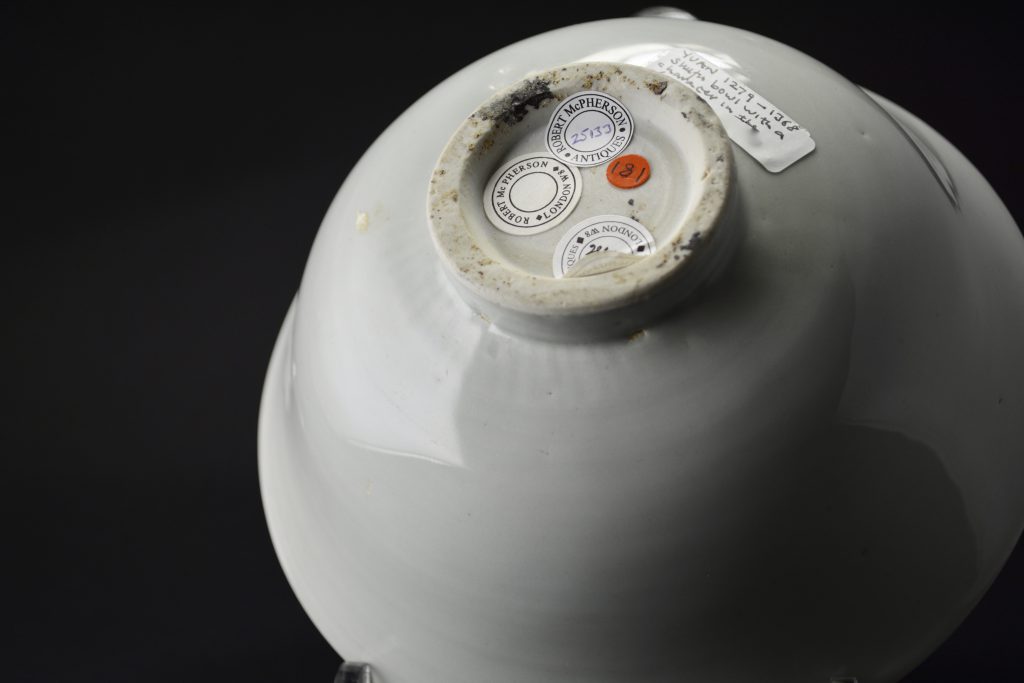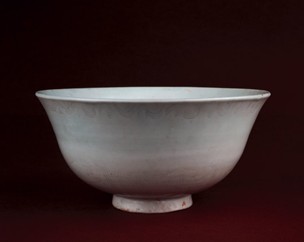
A Yuan Shufu Porcelain Bowl 1279 -1368
A rare Yuan Dynasty Shufu porcelain bowl, Hutian kilns Jingdezhen, Jiangxi province, early to mid-14th century. Decorated in low-relief with classical Chinese scrolling flowers which contain an auspicious Chinese character. The bowl is substantially potted being particularly thick in the base and square section foot. The glaze has a typically greyish tinge to it with some kiln grit in the well of the bowl.
SOLD

- Condition
- In excellent condition, the well might have been lightly polished.
- Size
- Diameter : 17.1 cm (6 3/4 inches) Height : 7.2 cm (2 3/4 inches)
- Provenance
- Robert McPherson Antiques. The John Drew Collection of Chinese and Japanese Ceramics. John Drew was born in 1933 in Tideswell, Derbyshire, where his father was curate. The family moved to Norfolk whilst he was still a baby and his father became the rector of the parish of Intwood and Keswick. He was educated at Sedbergh School and after National Service in the R.A.F. being taught Russian, he went to Queens College, Oxford to read Greats (Classics). He spent nearly all his working life in various African countries as an archivist, moving to a post at Cape Town University in 1978. He remained in Cape Town after his retirement until his death in 2006. He had a great love of the English countryside (but not the climate) and this is shown in many of the pieces he collected. His taste was varied and ranged from Neolithic right through to the 18th Century. When we sent photograph to his home in Cape Town of pieces we thought he might be interested in, he would write long funny well observed letters back, wanting to add many of the items to his growing collection. Over the years we got to know him better and better, and during the last few years it was very rare for him to not want all the pieces we offered him. We knew his taste, even though his taste was so varied. This was in no small part because he had a very good eye and it was a pleasure finding things that interested him, because they were also very interesting to us. He never got to put his collection on display, something he hoped to do while on retirement in England, so it is with a mixture of pleasure and sadness that we offer these pieces from his collection. Each piece has a John Drew collection label, so when the collection is split up there will be some lasting record of the love and hard work he put into his two decades of collecting.
- Stock number
- 25133
Information
Shufu / Luanbai :
Shufu is a very specific type of Chinese white porcelain ware made during the Yuan dynasty (1279-1368) in Hutian village just outside the city of Jingdezhen, Jiangxi province. Thought to be the first known porcelain ordered by imperial officials. The body of the ware is covered with a soft, white, bluish opaque glaze similar to qingbai, but contained less calcium oxide resulting in slight translucency rather than transparency. The bases are unglazed and the paste is of the typical early natural porcelain clay of Jingdezhen. Many have moulded low-relief decoration. The ware takes its name from the Chinese characters shu and fu, which appear in low relief on the interior on some bowls and dishes (literally "central palace," or "privy council"). These are believed to have been made for the Shumiyuan, a government department. Other, auspicious, characters also appear on porcelains of this type, some of which were exported.
Luanbai (egg white glaze) and shufu are two different names for the same glaze. The term shufu became the accepted name (and more often used) as so many items with this glaze bore the characters of shu and fu in relief on their interiors. Their glaze was more opaque than that of qingbai and had a silky rather than a glossy texture, hence the ware's other name luanbai (egg white).
During the Yuan period the Jingdezhen potters made some relatively minor adjustments to the highly successful qingbai glaze's composition creating two new glazes, the shufu/luanbai glaze and as a further developement the glaze used with underglaze blue decoration. The basic difference between qingbai, shufu/luanbai and the glaze on the underglaze blue wares was the amount of calcium oxide they contained. Qingbai contains 12-13%, shufu/luanbai 5-6%, and the glaze used on Yuan blue and white wares was 8-10%. Information (partly re-written) from http://gotheborg.com
A Marked Shufu Bowl at the British Museum
The bowl has a white body and blue-toned glaze. There is a scrolling pattern incised at the exterior rim, a lotus pattern at the exterior base, and geese among clouds beneath a classical scroll moulded on the interior.
There is a mark in the centre of the interior on the interior 'shufu' 樞府 (Privy Council) .
The base is unglazed.
-
Room 95. PDF A454

The John Drew Collection of Chinese and Japanese Ceramics :
John Drew was born in 1933 in Tideswell, Derbyshire, where his father was curate. The family moved to Norfolk whilst he was still a baby and his father became the rector of the parish of Intwood and Keswick. He was educated at Sedbergh School and after National Service in the R.A.F. being taught Russian, he went to Queens College, Oxford to read Greats (Classics). He spent nearly all his working life in various African countries as an archivist, moving to a post at Cape Town University in 1978. He remained in Cape Town after his retirement until his death in 2006. He had a great love of the English countryside (but not the climate) and this is shown in many of the pieces he collected. His taste was varied and ranged from Neolithic right through to the 18th Century. When we sent photograph to his home in Cape Town of pieces we thought he might be interested in, he would write long funny well observed letters back, wanting to add many of the items to his growing collection. Over the years we got to know him better and better, and during the last few years it was very rare for him to not want all the pieces we offered him. We knew his taste, even though his taste was so varied. This was in no small part because he had a very good eye and it was a pleasure finding things that interested him, because they were also very interesting to us. He never got to put his collection on display, something he hoped to do while on retirement in England, so it is with a mixture of pleasure and sadness that we offer these pieces from his collection. Each piece has a John Drew collection label, so when the collection is split up there will be some lasting record of the love and hard work he put into his two decades of collecting.





















